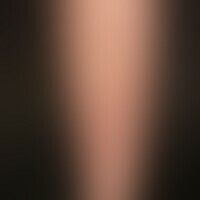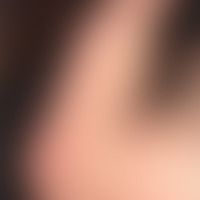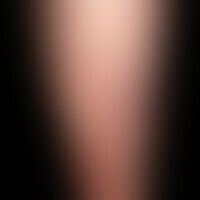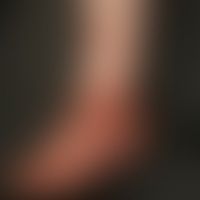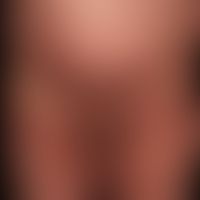
Livedo racemosa (overview) M30.8
Livedo racemosa generalisata: extensive, bizarre, haemorrhagic reticulation of the skin

Nodular vasculitis A18.4
Erythema induratum. 52-year-old secretary has been suffering for 3 years from this moderately painful lesion running in relapses. Findings: Clinical examination o.B. Local findings: 10 cm in longitudinal diameter large, firm plaque, interspersed with cutaneous and subcutaneous nodules. In the centre scarring, on the edge deep, poorly healing ulcerations (here crusty evidence).
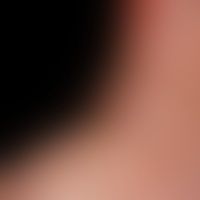
Arterial leg ulcer L98.4
Ulcus cruris arteriosum:Painful arterial leg ulcer of the lower leg and the back of the foot that has been present for 1 year and is continuously growing and sharply defined; proven PAVK in smokers' history and type 2 diabetes; destruction of tendons (arrow markings).
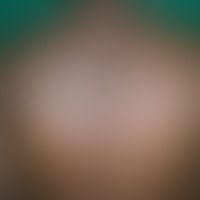
Herpes simplex virus infections B00.1
Herpes simplex virus infection:multilocular herpes simplex infection in zosteriform arrangement.
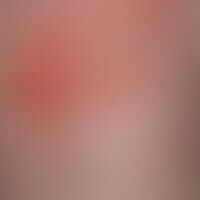
Pemphigoid bullous L12.0
Pemphigoid, bullous. detail enlargement: Multiple, sometimes several cm wide, flaccid blisters with serous content and extensive erosions on the left foot back of a 78-year-old patient.

Angiokeratoma circumscriptum D23.L
Angiokeratoma circumscriptum. localized vascular malformation with bizarre blue-black papular and nodular lesions. no symptoms. increasing prominence of the herd in recent years.
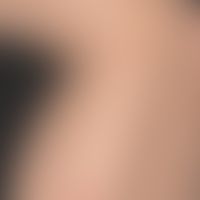
Artifacts L98.1
Multiple, round, "eczematous" flat, sharply defined ulcerations in an otherwise healthy 27-year-old female patient. CVI, AVK or immunological underlying diseases were not detectable.

Lichen planus classic type L43.-
Lichen planus (classic type): moderately itchy, disseminated, like scattered distribution pattern, red-violet colour of the surface smooth, shiny papules and plaques.
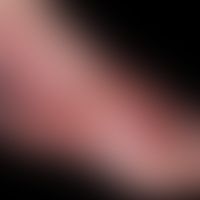
Pyoderma gangraenosum L88
Pyoderma gangränosum. initial findings lasting for years with therapy resistant ulcers. hypertrichosis after several months of unsuccessful therapy with cyclosporine.

Acrodermatitis chronica atrophicans L90.4
Acrodermatitis chronica atrophicans. clearly visible, flabby skin atrophy and edematous redness on the right foot in a serologically proven infection with borrelia. the comparison to the left leg shows the clear difference. the patient spends several months in the black forest every summer.

Fixed drug eruption L27.1
Drug reaction, fixed (detail). two red, sharply defined, moderately itchy plaques, existing for a few days. the peripheral areas are lighter in colour, tendency to blistering in the centre. irregular intake of headache medication known and admitted.

Artifacts L98.1
Artifacts: Multiple weeping ulcers without apparent reason, non-itching flat ulcers up to 3.0 cm in diameter in an otherwise completely healthy patient.
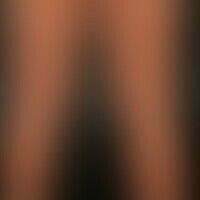
Lymphomatoids papulose C86.6
Lymphomatoid papulosis: chronic, relapsing, completely asymptomatic clinical picture with multiple, 0.3 - 1.2 cm large, flat, scaly papules and nodules as well as ulcers. 35-year-old, otherwise healthy man

Cholesterol embolisation syndrome T88.8
Cholesterol embolism: Sudden, highly painful, hemorrhagic lesions that turn into painful, jagged ulcers of varying depths within a few days.
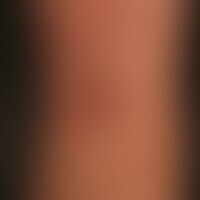
Mycosis fungoid tumor stage C84.0
Mycosis fungoides tumor stage: Mycosis fungoides has been known for years and has been present for about 3 months in this non-itching or painful plaques and nodules.
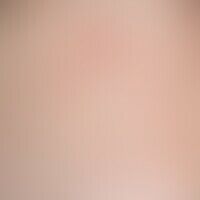
Varice reticular I83.91

Vasculitis leukocytoclastic (non-iga-associated) D69.0; M31.0
vasculitis, leukocytoclastic (non-IgA-associated). multiple, acute, symmetric, localized on both legs for 2 weeks, symptomless, red, smooth spots and plaques. localized aspect of erythema multiforme.

Calcinosis cutis (overview) L94.2
Calcinosis cutis: blurred, in places rock-hard indurated papules and nodules, focal pain on firm palpation, surface atrophic, no longer detectable follicular structure.
